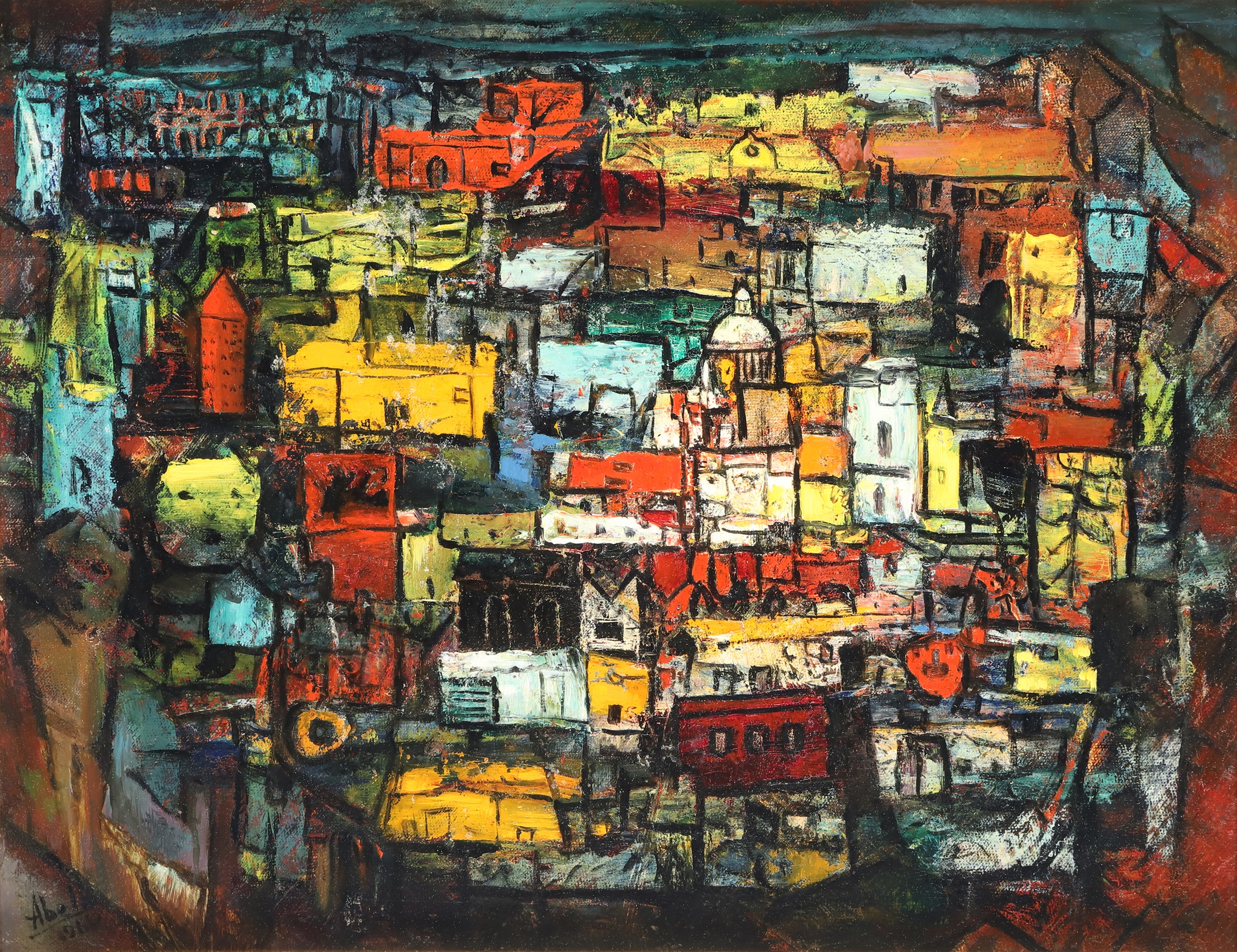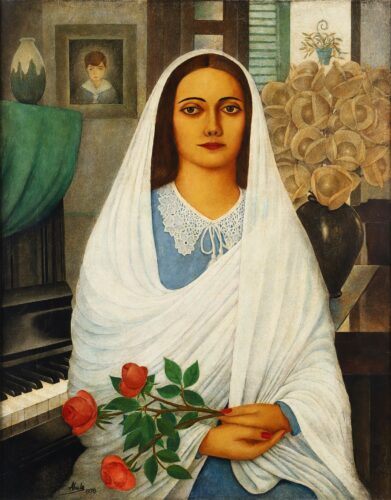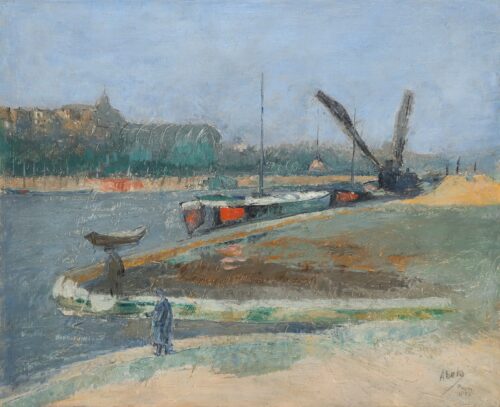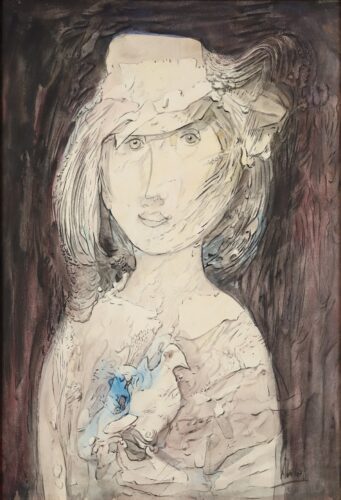Artburst Extras
Eduardo Abela, the Painter Who Returned from Oblivion

“Eduardo Abela: Homage to the Isaac and Betty Rudman Collection” showcases 45 works by the Cuban modernist, many of them being exhibited publicly for the first time. The retrospective is on view through Friday, May 30 at Latin Art Core Fine Art Gallery in Miami. Pictured, “Ciudad Habana” (1960), oil on wood. (Photo by Rogelio López Marín, courtesy of Latin Art Core Fine Art Gallery)
Two years ago, when Israel Molerio, the director of Latin Art Core Fine Art Gallery in Miami began planning an exhibition of Cuban artist Eduardo Abela, he knew he was undertaking a truly special project. “Abela is a painter whose work is rarely found on the market. He wasn’t prolific, and on top of that, a significant portion of his production is held in a single collection — that of Isaac and Betty Rudman,” explains Moleiro.
Born from a close collaboration with the collectors, who are regarded as building one of the most comprehensive Latin American art collections of the 21st century, “Eduardo Abela: Homage to the Isaac and Betty Rudman Collection” brings together 45 works by the artist, many being shown to the public for the first time. The exhibition is on view at Latin Art Core Fine Art Gallery through Friday, May 30.

The portrait of Eduardo Abela’s wife — “Carmen con piano al fondo”(1938), oil on canvas stands as one of the most emblematic works from the artist’s brief but significant neoclassical period. (Photo by Rogelio López Marín, courtesy of Latin Art Core Fine Art Gallery)
“Eduardo Abela is an artist whose work has left an indelible mark on the history of Cuban art,” says Moleiro, explaining that the artist was one of the key figures of the so-called First Vanguard of the 20th century, alongside Amelia Peláez, Víctor Manuel, and Carlos Enríquez.
“His unique style and his critical yet poetic approach reflect the social and cultural complexities of his time, all conveyed with remarkable sensitivity and mastery,” says Moleiro.
In the exhibition catalog essay, “Eduardo Abela: Memory, Resilience, and Identity,” art critic Janet Batet reinforces this view of Abela as a central figure in Cuba’s artistic landscape. She writes: “Abela’s contribution to the history of Cuban art is not merely stylistic; it is deeply rooted in cultural and political commitment, shaping and redefining national identity through visual means.
Moleiro explains that the exhibition is organized chronologically, covering works from the 1920s to Abela’s death in 1965. “There are three major phases in his work: the formative stage, where he explored styles like Impressionism; a second phase linked to Surrealism during his time in Paris; and a final, much-celebrated period where he developed a deeply personal figurative style, rich with symbolism and color,” explains Moleiro.

“Vista del Sena” (1927), oil on wood is featured in “Eduardo Abela: Homage to the Isaac and Betty Rudman Collection” at Latin Art Core Fine Art Gallery. (Photo by Rogelio López Marín, courtesy of Latin Art Core Fine Art Gallery)
Abela’s artistic journey began at Havana’s San Alejandro Academy, where he trained as a painter. After graduation, he traveled to Spain in the early 1920s, then moved to Paris, where he studied at the Académie de la Grande Chaumière, renowned for fostering creative freedom and experimentation.
Moleiro highlights a work created for Abela’s first Paris show at the Sachs Gallery in the late 1920s. “It was a highly important exhibition, even coinciding with a show by (Maurice) de Vlaminck at the same gallery,” he recalls. According to Moleiro, it was during this period that Abela established himself within the Surrealist movement, drawing inspiration from both Cuban folklore and the European avant-garde.
Abela was not just a painter, but a political cartoonist, too, according to Moleiro. producing pieces critical of the dictatorship of Gerardo Machado, Cuba’s fifth president between 1925 and 1933. He also had a distinguished diplomatic career, as well, holding posts in Milan, Mexico, and Bogotá.
“That explains why his body of work isn’t extensive: he wore many hats and didn’t rely solely on art sales for his livelihood,” says Moliero.

According to curator Israel Moleiro, one of Abela’s most distinctive traits was his preference for small-scale works. Pictured: “Niña con paloma” (1950), watercolor on paper. (Photo by Rogelio López Marín, courtesy of Latin Art Core Fine Art Gallery)
One of Abela’s most distinctive traits was his preference for small-scale works. “Although some pieces from the 1940s reach medium dimensions, most of his later works don’t exceed 10 by 14 inches. But that doesn’t mean they’re lesser works. They are incredibly intricate, with glazes, scratches, and layers of paint — meticulous craftsmanship reminiscent of Chagall, whom he met in Paris,” he says. Moleiro adds, “That level of detail required extreme patience. Attempting it on a large scale would have been nearly impossible.”
Moliero says there hasn’t been an exhibition of this magnitude on Abela in the United States in decades.
Many of the 45 pieces in the exhibition had previously existed only as grainy black-and-white images in art books and archives, according to Moleiro. Now, for the first time, they can be seen in vivid color, each brushstroke and detail offering fresh insight into an artist whose legacy continues to shape Cuban modernism.
“Two generations have gone by without the chance to see these works,” he says. “Now they finally have that opportunity.”
WHAT: “Eduardo Abela: Homage to the Isaac and Betty Rudman Collection”
WHERE: Latin Art Core Fine Art Gallery, Miami
WHEN: 11 a.m. to 7 p.m., Monday through Friday; 11 a.m. to 5 p.m. Saturday. Through Friday, May 30.
COST: Free
INFORMATION: 305-773-2882 or latinartcore.com
ArtburstMiami.com is a nonprofit media source for the arts featuring fresh and original stories by writers dedicated to theater, dance, visual arts, film, music, and more. Don’t miss a story at www.artburstmiami.com
